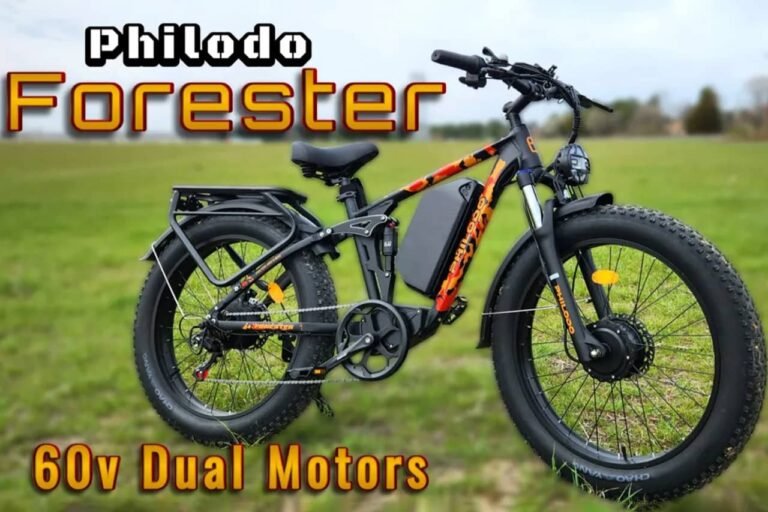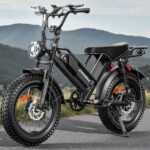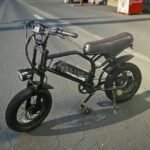![Real-World isinwheel M60 Test ([year]): 28 MPH Speed, 65-Mile Range & Daily Utility isinwheel M60 Electric Bike Review](https://goebikelife.com/wp-content/uploads/2025/07/isinwheel-M60-Electric-Bike-Review.jpg)
![Real-World isinwheel M60 Test ([year]): 28 MPH Speed, 65-Mile Range & Daily Utility isinwheel M60 Electric Bike hero image](https://goebikelife.com/wp-content/uploads/2025/07/isinwheel-M60-EBike.jpg)
isinwheel M60 Electric Bike — 750W Class 3 Step-Thru Fat-Tire
Our verdict: a comfortable, all-terrain commuter with hidden 48V battery, adaptive 750W power to 28 mph, and practical rack & fenders out of the box.
- 750W Class 3 motor (28 mph) with adaptive power for hills & headwinds
- 48V 13Ah hidden, lockable battery • 45–65 mi range • USB-C display charge
- 26×4.0 fat tires + adjustable fork + cushy saddle for all-terrain comfort
- Motor
- 750W (Class 3)
- Battery
- 48V 13Ah (UL)
- Top Speed
- Up to 28 mph
- Range
- 45–65 miles
The isinwheel M60 is a step-thru, fat-tire Class 3 e-bike built to do two things well: make commuting painless and turn off-road detours into fun. It pairs a 750W rear-hub motor with a removable, frame-integrated 48V 13Ah battery, and it rolls on 26×4.0-inch “automotive-grade” tires. On paper, that combo promises speed up to 28 mph, respectable range, and the kind of floating comfort people expect from a 4-inch tire bike.
What stands out at first glance is how tidy the bike looks. The battery is hidden in the down tube, wiring is routed cleanly, and the step-thru frame is genuinely easy to mount—even wearing a backpack or carrying groceries. The fork is adjustable, the saddle uses a shock-absorbing design, and the rear rack and fenders come installed, so you’re not chasing accessories on day one.
Under the skin, isinwheel adds a few quality-of-life touches. The display includes a USB-C charging port to keep your phone topped up, the electronics carry UL and IPX5 claims for safety and water resistance, and a built-in horn and bright lighting keep you visible. The M60 reads like a practical, do-everything ebike for people who want real utility with a side of adventure.
Is the isinwheel M60 for you?
If you’re looking for a comfortable, capable, and low-maintenance way to commute, run errands, or explore trails and beach paths, the M60 hits a sweet spot. Its 750W motor gives you confident acceleration and enough headroom to hold Class 3 speeds, and the fat tires mute broken pavement and gravel. The 330-lb max payload and step-thru frame also make it friendly for a wide range of rider sizes and abilities.
It’s especially well suited to riders who want to ride year-round. The integrated battery and IPX5 water resistance help in rain, while the 26×4.0 tires add grip on sand, snow, and mud. The upright posture, cushy contact points, and adjustable fork deliver all-day comfort. If you’re new to e-bikes, the five assist levels and four riding modes keep the learning curve gentle.
On the other hand, performance obsessives chasing the ultra-light feel of a carbon commuter, or the hyper-natural pedaling of a mid-drive with a torque sensor, will likely want to spend more. At roughly 76 lb, the M60 is built for stability and durability, not featherweight portability. If you need to carry a bike up multiple flights of stairs every day, be realistic about that.
In terms of budget, the M60 sits in the budget to lower-mid tier for a Class 3 fat-tire e-bike. That’s important: you’re getting a lot of bike for the money—integrated battery, comfort suspension, rack/fenders, and a Class 3 motor—without jumping to premium pricing. For most commuters and weekend explorers, it’s a strong value.
What We Like About the M60
The M60’s ride quality is its standout. Those 4-inch tires, paired with an adjustable fork and shock-absorbing saddle, flatten rough pavement and chatter. You get that “nothing fazes it” feeling that makes longer rides less tiring. The step-thru frame is genuinely practical; hopping on and off at traffic lights or loading panniers is a breeze.
Power delivery is easygoing but decisive. The “adaptive power” behavior adds assistance when you tip into a hill or push into a headwind. You don’t need to overthink modes—leave it in your preferred assist level and it just goes. Top speed up to 28 mph means you can mix with city traffic when you must, and the bike doesn’t run out of breath on flat paths.
We also appreciate the everyday usability pieces. The battery slides out for convenient indoor charging and locks in place for security. The claimed 45–65-mile range is ambitious, but realistic riders using PAS 2–3 will find the M60 easily covers typical daily needs. The USB-C charge port on the display sounds minor until you realize you’ll never finish a ride with a dead phone.
Lastly, fit and flexibility. With 330 lb max load and that sturdy rear rack, you can add baskets or bags for grocery runs, camera gear, or a laptop setup. The seatpost and handlebar rise give a wide adjustment range, and the bike exists in several colors for a clean, modern look.
What We Don’t Like About the M60
The weight is the first compromise. At around 75.9 lb, the M60 is steady and confidence-inspiring at speed, but carrying it up stairs or hoisting it onto a rack isn’t fun. If you regularly need to lift your bike, plan accordingly.
Charging time is another trade-off. The included 3A charger needs about 7–8 hours from low to full. Overnight charging solves it, but fast-charge fans might wish for a higher-amp option. We’d also flag that fat tires are inherently heavier and a bit louder on pavement than 2–2.4-inch commuter tires; that’s the price of their float-anywhere capability.
Riders who crave a hyper-natural pedaling feel may find the assistance a little more “assist-forward” than refined. It’s comfortable and predictable for commuting, just not tuned for performance purists. Finally, while the lighting and horn are better than basic, the saddle and pedals are standard fare—perfectly fine to start, but easy upgrade targets if you ride 100+ miles a week.
Pros & Cons
| Pros | Cons |
|---|---|
| Class 3 assistance up to 28 mph with confident 750W power | Heavy at ~75.9 lb; not ideal for frequent stair carries |
| Removable, integrated 48V 13Ah UL-certified battery | 7–8 hour charge time with stock 3A charger |
| 26×4.0 automotive-grade fat tires glide over sand, snow, gravel | Fat tires add rolling noise and weight on pavement |
| Adjustable front fork + shock-absorbing saddle = very comfy | Assistance feel favors comfort vs performance-purist tuning |
| Rear rack & fenders included; step-thru frame is truly practical | Stock saddle/pedals are fine but upgrade-worthy for high mileage |
| IPX5 water resistance; tidy cable routing; lockable battery | If you want torque-sensor finesse or mid-drive efficiency, look higher |
| USB-C port on display keeps your phone charged | |
| Max load 330 lb; easy to accessorize with baskets/bags |
What’s Included?
- isinwheel M60 step-thru fat-tire electric bike (mostly pre-assembled)
- 48V 13Ah removable, integrated battery (UL-certified)
- 3A charger and power cable
- Two battery keys
- Rear cargo rack (installed)
- Full-coverage fenders (installed)
- Front headlight and flashable taillight
- Integrated electronic horn
- Kickstand
- Basic multi-tool and installation hardware
- Reflectors and bell (varies by region)
- User manual and warranty/quality card
Packaging & first-ride impression: The bike arrives well protected, and final assembly is straightforward if you’ve built a bike before—attach the handlebar, check the front wheel and brake alignment, thread on the pedals, and you’re largely done. Everything you need for a first week of commuting is in the box; you’re not hunting for a rack or fenders. The only “wish list” items would be a phone mount and maybe a spare tube—nice-to-haves that many riders will add anyway.
Technical Specifications
| Component | Spec / Claim |
|---|---|
| Frame | Step-thru alloy steel frame with integrated down-tube battery housing |
| Motor | 750W rear-hub; Class 3 assistance up to 28 mph |
| Battery | 48V 13Ah removable, lockable; UL-certified; BMS protection |
| Claimed Range | 45–65 miles per charge (realistic: ~25–45 miles with mixed PAS) |
| Charging | 100–240V, 3A charger; ~7–8 hours from low to full |
| Display & Controls | Backlit LCD with 5 PAS levels; built-in USB-C phone charging |
| Riding Modes | 4 modes: Normal bike (PAS 0), Pedal-assist, Pure electric, Walk assist |
| Gearing | Shimano 7-speed |
| Tires | 26×4.0-inch “automotive-grade” fat tires |
| Suspension | Adjustable front fork; shock-absorbing saddle |
| Brakes | Disc brakes (front & rear) |
| Water Resistance | IPX5 |
| Dimensions | 74.0 × 46.5 × 25.2 in (188 × 118 × 64 cm) |
| Weight | 75.9 lb (net) |
| Max Load | 330 lb (150 kg) |
| Operating Temp | –4°F to 140°F |
Features
- Adaptive Power assistance reacts to hills, headwinds, and added load, keeping cadence steady without micromanaging PAS.
- Hidden, removable battery improves weather sealing and the bike’s clean look, and it’s easy to pop out for indoor charging.
- 26×4.0 fat tires add float and grip on sand, snow, dirt, and rough pavement.
- Class 3 speed up to 28 mph shortens commutes and keeps pace with city traffic.
- Four riding modes plus five assist levels let you tailor effort from workout to effortless cruise.
- USB-C charging on the display keeps navigation and music going for long rides.
- Integrated utility: rear rack, full fenders, kickstand, lights, and horn are standard.
- IPX5 water resistance and tidy cable routing suit all-weather riding.
- High payload (330 lb) and step-thru geometry fit a wide range of riders and cargo setups.
Take on the features: The M60 focuses on real-world usability over exotic tech. That’s the right call in this category. The adaptive power logic reduces fiddling with buttons, the integrated battery keeps grime out, and the fat tires do the heavy comfort lifting. Add in the rack, fenders, and lighting, and the bike rolls out of the box commute-ready. If you crave surgical pedaling feel or ultra-light weight, you’ll look upmarket; for everyone else, the M60’s spec hits the practical bullseye.
Riding Experience
Comfort & fit. The cockpit is relaxed and upright, taking pressure off wrists and lower back. Between the wide tires, adjustable fork, and springy saddle, you can ride rough streets without bracing for every crack. Riders who typically add a suspension seatpost to commuter bikes may find they don’t need one here.
Power & speed. From a stop, the motor engages smoothly, and rolling to 20–23 mph happens without strain. Pushing toward 28 mph is doable on flat paths, especially with a bit of rider input in higher gears. On moderate hills—the kind you actually see in cities—the motor maintains speed well, and the “extra boost” feel when you hit a grade is welcome.
Handling. Fat-tire bikes sometimes feel vague in quick transitions; the M60 manages that with predictable steering and a low center of gravity courtesy of the integrated battery. It feels planted at speed and stable over potholes. The trade-off is that tight, fast slalom moves aren’t its specialty—this is a confidence bike, not a crit racer.
Noise & refinement. The drive system hums along quietly. Most of the soundtrack is the tires on pavement, which is normal for 4-inch rubber. Chain slap is minimal with proper tension, and the fenders are rattle-free once everything is tightened after your first few rides.
Range use-case. For mixed urban riding—PAS 2–3, stop-and-go traffic, and occasional hills—expect a comfortable 25–45 miles before you’re thinking about a charge. Lower PAS on flat paths can stretch range; full-time throttle will shrink it. The battery meter is readable at a glance, and the USB-C port means turn-by-turn navigation won’t drain your phone.
Everyday Practicality
The M60’s 330-lb payload and sturdy rear rack invite real cargo. A pair of panniers turns it into a grocery getter or laptop hauler. The step-thru frame is a sleeper feature: it’s not just for mobility; it makes starts and stops safer in dense traffic and keeps you from swinging a leg over a loaded rack.
Security & storage. The battery locks to the frame and removes for indoor charging—useful in apartments and workplaces that don’t allow bikes inside. Because of the bike’s weight, we recommend a solid ground anchor or heavy U-lock when parking outside. If you’re transporting in a car, a ramp or a hitch rack rated for fat tires saves your back.
Weather. The IPX5 claim and integrated battery housing make rain rides low drama. The fenders are full-coverage enough to keep your feet and back clean, and the lights are bright enough for dusk commutes. Fat tires on wet paint lines still demand respect—drop PAS a level and ride smoothly.
Maintenance & Upgrades
Fat-tire commuters are low-maintenance if you keep up with basics:
- Tire pressure is the biggest variable in ride feel. Start around 18–22 psi for mixed city riding and adjust for your weight and cargo.
- Chain & cassette: Lube every 100–150 miles in wet conditions, 200–300 in dry.
- Bolts & spokes: Re-torque after the first 50 miles as the bike “beds in.”
- Brake pads: Check wear monthly; fat-tire weight means pads do real work.
Easy upgrades that move the needle: a suspension seatpost for riders with sensitive backs, puncture-resistant tubes or liners if your route is debris-heavy, and panniers that fit your daily carry. If you ride long descents with a heavy load, better-compound pads are an inexpensive confidence boost.
How It Compares
Within budget and lower-mid price brackets, many fat-tire e-bikes tick similar boxes, but the M60’s integrated battery, USB-C charging, and comfort package help it stand out. Bikes at this price often make you add racks and fenders; here they’re standard.
To beat it meaningfully, you typically move up in price for a torque-sensor mid-drive or hydraulic brakes—and you often lose the simplicity and low upkeep that make hub-drives attractive.
Who Will Love It (and Who Won’t)
You’ll love it if:
- You want one bike that does weekday commuting and weekend exploring.
- Comfort matters as much as speed, and you don’t want to tinker.
- You haul groceries, a backpack, camera gear, or a kid’s soccer bag.
- You ride in mixed weather and value sealed, integrated components.
You might look elsewhere if:
- You carry a bike up stairs daily and need sub-60-lb weight.
- You’re chasing featherweight road-bike feel or torque-sensor finesse.
- You demand fast charging or plan century-length rides without pedaling.
Final Breakdown
| Preview | Product | Price | |
|---|---|---|---|
|
|
isinwheel M60 Electric Bike for Adults 750W 28mph Ebike with 48V 13Ah Removable Battery, USB… | View on Amazon |
9.1 / 10
The isinwheel M60 nails the mission of a modern, do-everything e-bike. It’s fast enough for urban mixing, stable enough for dirt and sand, and comfortable enough to make 10-mile commutes feel short. The ride quality is the hook—between the fat tires, adjustable fork, and shock-damping saddle, you simply glide. Add the integrated battery, USB-C charging, and Class 3 speed, and it feels like a complete solution out of the box.
It’s not perfect: weight and charge time are the predictable trade-offs, and performance purists will still want a pricier mid-drive. But taken as a whole, the M60 is an excellent value for riders who want utility, comfort, and genuine all-terrain capability without fuss. For commuters, errand-runners, and path explorers, it’s an easy recommendation.



![Is the Rideplux EB5 the Best Value E-Bike of [year]? Full Hands-On Review Rideplux EB5 Electric Bike Review](https://goebikelife.com/wp-content/uploads/2025/06/Rideplux-EB5-Electric-Bike-Review-768x512.jpg)
![Best Electric Bikes Under $2000 in [year]: Real Range, Power, and Value Compared Top Sub-$2000 E-Bikes for Commuting & Trails: Batteries, Brakes, and Speed](https://goebikelife.com/wp-content/uploads/2025/09/Best-Electric-Bikes-Under-2000-768x512.jpg)




